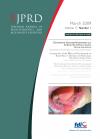European Journal of Prosthodontics and Restorative Dentistry

- Cover Date:
- March 2009
- Print ISSN:
- 0965-7452
- Vol:
- 17
- Issue:
- 1
The Prevalence of Temporomandibular Disorders Among Two Different Denture-wearing Populations
Abstract - Aim. The aim of this clinicostatistical study was to proï¬le the complete denture wearers of two different populations, to determine any possible relationship between the prevalence of temporomandibular disorders (TMDs) and factors involved in complete denture wearing and to compare this prevalence between the groups. Materials and Methods. Denture wearers who attended the clinics of the Dental School and Hospital, University of Bristol, U.K. (group A) and the Dental School, University of Athens, Greece (group B), were examined. An approximately equal number of patients; 115 for group A and 136 for group B, were selected. The examination included: a) a history record with reference to sex, age, years of complete denture experience, sets of dentures used, age of the current dentures, time period of every day denture wearing, any difï¬culties on opening the mouth, and/or pain at the temporomandibular joint (TMJ) region and b) a craniomandibular clinical examination in relation to midline deviation, pain and sounds from the joints, pain in the related muscles and inspection of the vertical dimension of occlusion. Data collected were analyzed using the chi-square test. Results. Denture wearers of group A were older, presented with greater experience in complete denture wearing, used more sets of dentures, most wore dentures exhibiting decreased vertical dimension of occlusion and wore their dentures only in the day time. The TMDs prevalence was not statistically signiï¬cantly different between A and B groups (34.8% and 41.2% respectively). In group B the TMDs prevalence was greater in females. There was a decreasing TMDs prevalence with increasing age. Neither of the groups showed signiï¬cant TMDs prevalence in relation to the denture experience, the number of dentures used, the age of the present denture nor the vertical dimension of occlusion. Group B showed a decreasing TMDs prevalence in relation to continuous denture wearing. Conclusions. This clinicostatistical study showed that two different population groups of complete denture wearers who presented with different proï¬les have similar prevalence of TMDs.
KEY WORDS: Temporomandibular disorder, temporomandibular dysfunction, temporomandibular joint, myofascial pain dysfunction syndrome, stomatognathic system, complete dentures, denture wearing.
- Article Price
- £15.00
- Institution Article Price
- £
- Page Start
- 35
- Page End
- 40
- Authors
- Stavros Yannikakis, Alcibiades Zissis, Alan Harrison
Articles from this issue
- Title
- Pg. Start
- Pg. End
- Comparison of the Effect of Ovariectomy on Bone Mass in Dentate and Edentulous Mandibles of Adult Rats
- 9
- 21
- Resin-bonded Cast Splints for Loosened Abutment Teeth to Anchor a Removable Partial Denture: A Case Report
- 22
- 25
- Computerised Dental Implant Rehabilitation Planning and Execution Following Mandibular Resection: A Case Report
- 26
- 29
- Investigation of the Effect of a Proprietary Dental Waterline Disinfectant on Shear Bond Strengths of Panavia 21 to Enamel and Dentine
- 41
- 46
